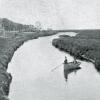Cape Henlopen Lighthouse stands in 1926
Ninety-eight years ago April 13, the iconic Cape Henlopen Lighthouse fell from its perch on top of a dune overlooking the Atlantic Ocean. A beacon that had stood along the coast since before the Revolutionary War was gone in the blink of an eye on what was reportedly a beautiful spring day.
According to Volume XVII of the Journal of the Lewes Historical Society, the lighthouse was completed in either 1765 or 1767; there are conflicting records. The cost to build the lighthouse was about £7,674. Adjusted for inflation, that amount is estimated to equal about £1.7 million, or about $2.14 million. It was built because of a high number of shipwrecks around Cape Henlopen. The tower was built using ashlar granite from quarries near Wilmington. According to the LHS journal, the stones were shipped to Lewes Creek dock, taken by shallow barge to about two miles from the construction site, then hauled the rest of the way by ox teams.
The exterior diameter at the base was 26 feet. The walls were 6 feet thick. It was 69-feet-3-inches from the base to the coping. It had eight levels and a window at each level. A keeper’s room was on the seventh level, just under the light room.
Shifting sands over 160 years eventually took their toll on the lighthouse. When built, it stood about two-thirds of a mile south of the cape. By the time it fell, the cape had grown by more than a mile. Although there were efforts to save the lighthouse from plunging into the ocean, they were not fast enough. About lunchtime April 13, 1926, the lighthouse fell. People from all over the area trekked out to see the rubble. Pieces of stone were taken as keepsakes, with many finding their way into the design of homes. Recently, stones on an old farmhouse along Route 1 were preserved when the structure was demolished to make way for a new Starbucks and shopping center. Many other stones exist on and in homes throughout the Cape Region.





















































